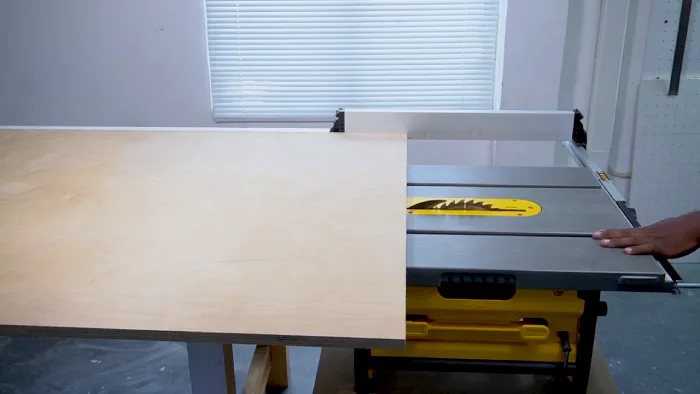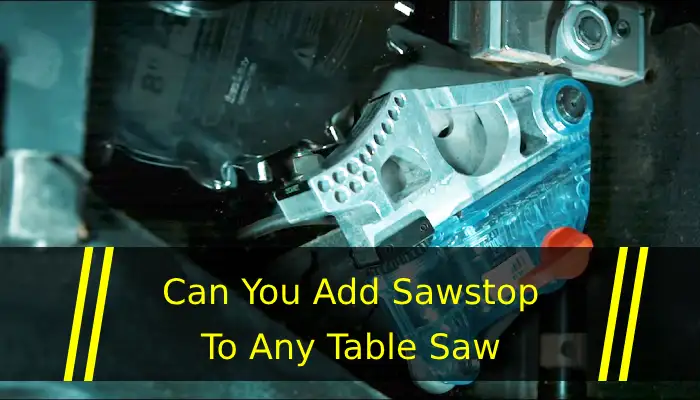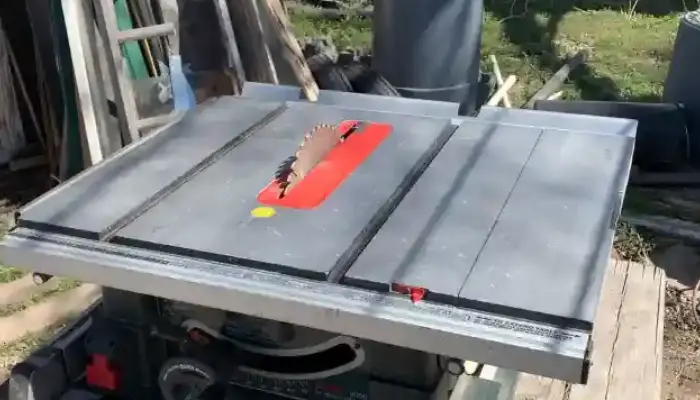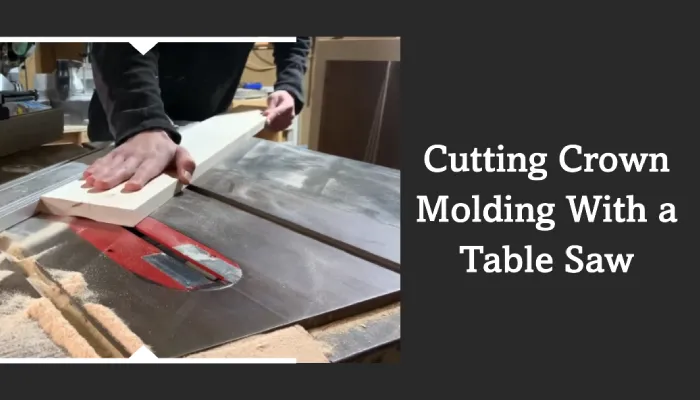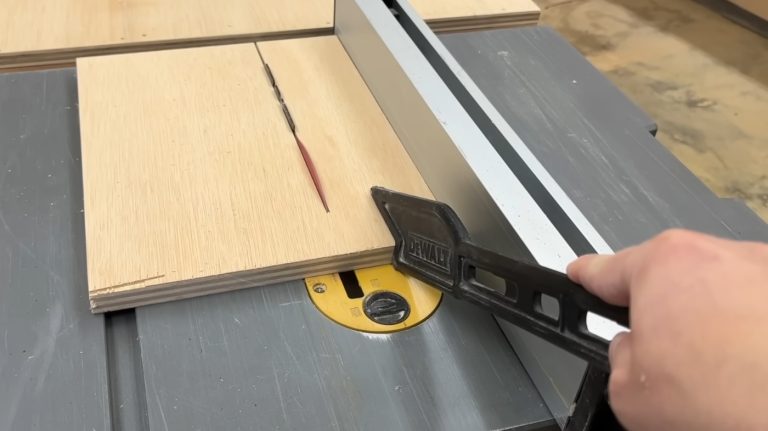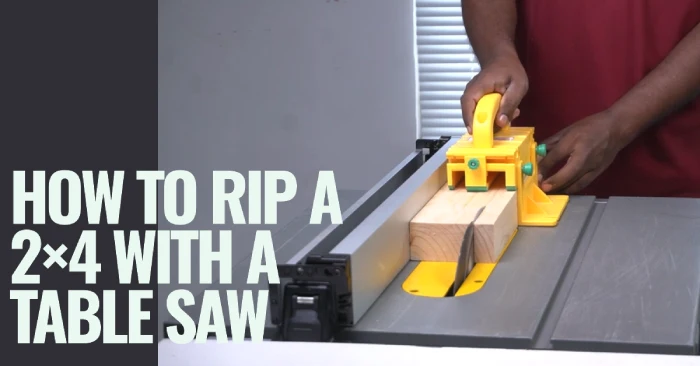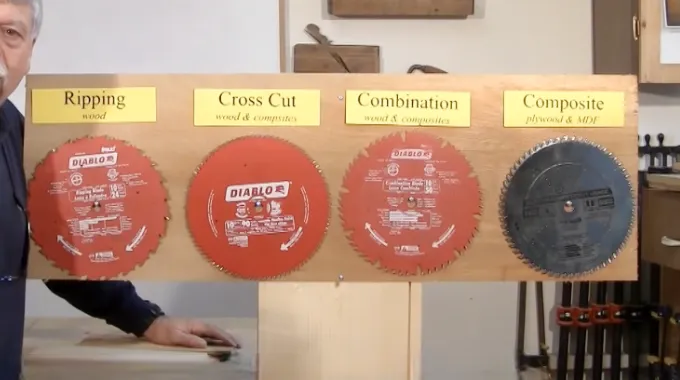How to Cut Plywood on a Table Saw: 5 Steps [DIY]
A table saw is a great tool for cutting plywood because it enables precise and quick straight cuts. However, using a table saw requires certain precautions to guarantee a successful and safe operation. So, what is the best way to cut plywood using a table saw for intricate cuts?
Set up your workspace properly to do it correctly, ensuring a stable and secure surface. After that, adjust the blade height to the appropriate level for your desired cut. Finally, start the cutting process, paying attention to accuracy and using the preferred method for large sheets.
In this comprehensive guide, I’ll explain seven DIY steps to master cutting plywood on a table saw, ensuring safety, accuracy, and efficiency. So keep reading.
5 Easy Steps to Cut Plywood on a Table Saw
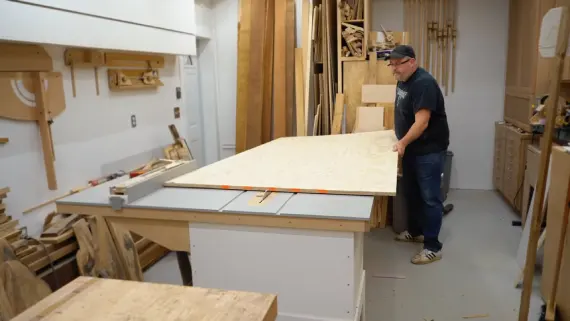
Cutting plywood on a table saw can be daunting, but you can achieve precise and clean cuts with the right knowledge and techniques. To successfully cut plywood on a table saw, follow the steps I’ve listed below:
- Proper setup for cutting success
- Blade height adjustment
- Start the cutting process
- Preferred method for large sheets
- Addressing accuracy issues
Step 1: Proper Setup for Cutting Success
Before cutting the plywood, you need to set up your table saw properly. Begin by placing the plywood sheet on the table, ensuring it’s well-supported and flat.
Use a measuring tape and pencil to mark your cut line on both ends of the plywood sheet. Connect these marks using a level or ruler to ensure a straight and accurate cut.
Measure the ripping width from the blade to the rip fence, aligning the cut line with the blade by adjusting the rip fence accordingly. Once aligned, lock the rip fence securely to maintain accuracy during the cutting process.
Step 2: Blade Height Adjustment
Now adjust the height of the blade on your table saw to approximately 1/8 inch higher than the plywood sheet. In my experience, this height adjustment is crucial for achieving clean and professional cuts without splintering the plywood.
Start by turning on the saw and allowing it to reach its full speed before you begin cutting. This ensures that the blade is operating at its optimal performance level.
Once the saw is ready, carefully adjust the blade height along with the reviving knife using the height adjustment wheel or knob on your table saw. Take your time to make small adjustments until the blade is positioned slightly higher than the plywood.
This slight height difference will help prevent tear-out and splintering, resulting in a cleaner and more precise cut.
Step 3: Start the Cutting Process
Align the factory edge of the plywood with the rip fence on your table saw, ensuring there’s no gap between the plywood and the fence for maximum cutting accuracy.
Feed the plywood slowly into the blade, applying pressure towards the fence. If cutting a large sheet, consider lifting the end to prevent sagging.
As you cut, watch the fence and the sheet, not just the blade, to ensure a straight and accurate cut. Maintain a steady pace and avoid rushing the process. Additionally, using an outfeed table to support the other end of the plywood during the cut will help prevent any unwanted bending or splintering.
Step 4: Preferred Method for Large Sheets
When working with larger sheets of plywood, I recommended taking the cutting process outdoors and utilizing sawhorses and a circular saw with a saw board for an initial cut, ensuring greater manageability and enhanced accuracy.
This method helps overcome space limitations and avoids obstacles that impede cutting. By taking the cutting process outdoors, you have more room to maneuver and position the plywood sheet, allowing for better control and reducing the risk of accidents.
The use of sawhorses provides a stable and elevated surface to support the plywood, making it easier to guide the circular saw along the marked cutting line. Additionally, using a saw board as a guide ensures a straight and precise cut, further enhancing the accuracy of the final result.
Step 5: Addressing Accuracy Issues
To ensure precise and accurate cuts when using a table saw to cut plywood, it’s crucial to address any potential accuracy issues that may arise during the cutting process.
One common issue to be mindful of is encountering obstacles such as plastic staples, which can affect the smoothness of the cut. Before cutting, measure the space and clear the work area to prevent interference.
Moreover, developing a specific feeding technique can greatly improve accuracy. This technique involves lifting the sheet with the right hand on the back, pushing down with the left hand on the front, and guiding the sheet against the fence.
Things to Consider When Cutting Long Plywood on a Table Saw
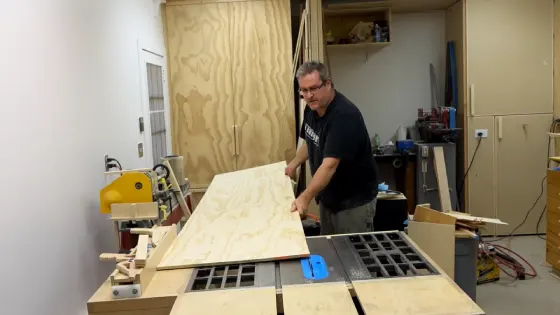
When cutting long plywood on a table saw, I’ve found several important factors you must consider.
Support and Stability
For optimal support and stability when cutting long plywood on a table saw, ensure that the entire length of the plywood is well-supported to prevent any sagging or flexing during the cut. This is crucial because any movement or instability can lead to inaccurate cuts or accidents.
You can use additional supports such as sawhorses or rollers to achieve this. Position these supports strategically along the length of the plywood, ensuring that they can carry the weight of the plywood without causing any strain.
Sawhorses are popular as they provide a sturdy base and can be adjusted to the desired height. On the other hand, I can also suggest using rollers to create a smooth, gliding surface, reducing friction and making it easier to guide the plywood through the saw.
Outfeed Table
Consider setting up an outfeed table at the same height as the table saw to provide support and control for the plywood as it exits the saw, preventing tear-out and ensuring a smooth cut.
An outfeed table is a dedicated surface that extends beyond the back of the saw, creating a seamless platform for the plywood to glide across.
Maintain a consistent and level surface to have the outfeed table level with the table saw. This allows the plywood to maintain stability and prevents any sagging or tilting that could result in uneven cuts or tearouts.
Infeed and Outfeed Clearances
To ensure a smooth and precise cut when working with long plywood on a table saw, maintain clear and unobstructed infeed and outfeed areas. Before cutting, clear the infeed and outfeed areas of any obstacles, debris, or tools. A clutter-free workspace is crucial to prevent interference during the cutting process.
Ensure there’s enough space in front of and behind the table saw to accommodate the length of the cut plywood. This will allow the plywood to move freely without getting caught or causing disruptions. Additionally, ensure that the outfeed area is clear to prevent any potential accidents or damage to the plywood.
Feeding Technique
Maintaining a clear and unobstructed infeed and outfeed area sets the foundation for a smooth and precise feeding technique when cutting large plywood on a table saw.
To ensure a steady and controlled feeding technique, guide the plywood evenly through the cut, avoiding sudden movements or jerks. This can be achieved by maintaining a consistent forward motion while feeding the plywood into the saw blade.
Using a helper to support the plywood at the outfeed end is also advisable, especially when dealing with longer sheets. This helps to prevent any sagging or bending of the plywood, ensuring a cleaner and more accurate cut.
Blade Height
Adjust the height of the table saw blade to a level slightly higher than the thickness of the plywood to ensure clean cuts and minimize tear-out.
The blade height is crucial when cutting long plywood on a table saw. If the blade is too low, it may cause tear-out and rough edges on the plywood. On the other hand, if the blade is set too high, it may result in a lack of control and safety issues.
To achieve the optimal blade height, measure the thickness of the plywood and adjust the blade accordingly. A good rule of thumb is to raise the blade about 1/8 inch higher than the plywood. This will allow the blade to cleanly cut through the plywood without causing damage or tear-out.
Cutting Speed
When cutting long plywood on a table saw, be sure to operate at a consistent and moderate feed rate to ensure a high-quality cut. Take your time and avoid rushing the process, as this increases the risk of mistakes and compromises the quality of the cut.
By maintaining a moderate feed rate, you allow the saw blade to do its work effectively. This means you should either push the plywood too quickly or slowly through the saw.
Pushing too quickly can cause the blade to bind, resulting in rough and uneven cuts. On the other hand, pushing too slowly can cause burn marks on the plywood and may lead to a less precise cut.
What is the best blade for cutting plywood on a table saw?
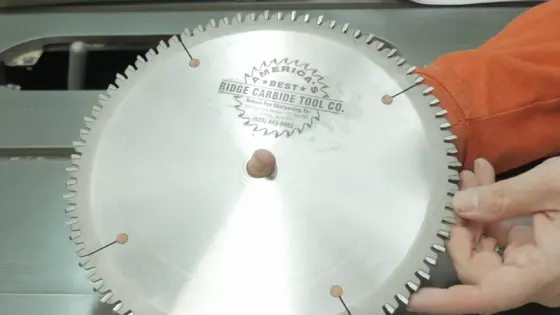
To achieve precise and clean cuts when cutting plywood on a table saw, I advised using a 40-tooth to 80-tooth blade or a 40-tooth to 50-tooth general-purpose blade. These blades are specifically designed to handle the unique properties of plywood, ensuring a smooth and accurate cut.
A blade with more teeth, such as the 80-tooth option, will provide finer cuts and minimize splintering. This is particularly important when working with plywood, as it easily chips and splinters.
Alternatively, a general-purpose blade with 40 to 50 teeth can cut plywood. While it may not provide the same level of precision as a higher tooth count blade, it can still produce satisfactory results for most projects.
Follow Some Simple Steps to Cut Plywood Efficiently on a Table Saw
Cutting plywood on a table saw can be achieved by following simple steps. You should consider the length of the plywood and use appropriate safety precautions.
Choosing the right blade is essential to ensure clean and precise cuts. For example, a case study conducted by a woodworking enthusiast showed that using a fine-toothed blade resulted in minimal tear-out and smooth edges on the plywood.
You need to prioritize safety, so take your time with the setup and explore advanced techniques as you become more comfortable with the process. Considering these factors, you can successfully cut plywood on a table saw efficiently and accurately.

